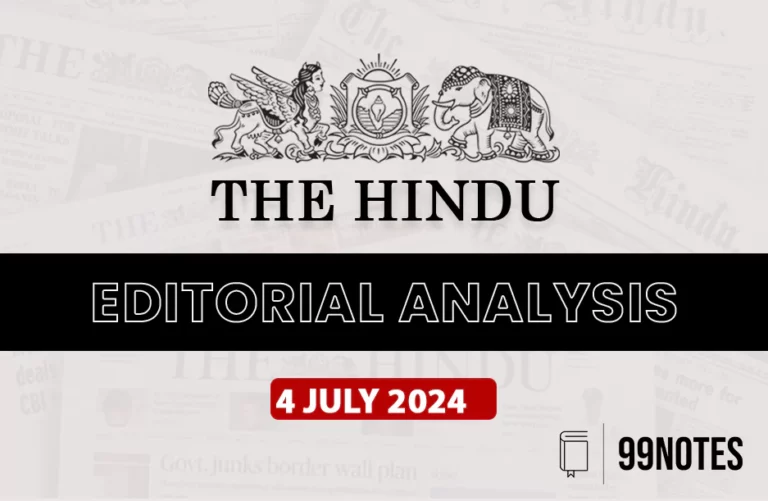31 May 2025 : Indian Express Editorial Analysis
1. Decoding GDP
(Source: Editorial Page, The Indian Express)
| Topic:
GS3: Indian Economy, Growth, Agriculture & Industry |
| Context |
|
GDP Numbers at a Glance
-
Q4 (Jan–Mar 2025) GDP growth: 7.4%
-
Full-year (2024–25) GDP growth: 6.5%, moderately strong
-
Nominal GDP growth: Below 10%, indicating weaker pricing power and deflationary trends
Real GDP looks promising, but nominal GDP, which matters for tax revenues and wages, is lagging—indicating underlying economic stress.
Strong Performance by Agriculture
-
Agriculture grew at 5.4% in Q4 and 4.6% for the full year, which is above the long-term average.
-
Driven by:
-
Good monsoons
-
Timely MSP hikes
-
Favorable weather for rabi crops
-
-
Positive impact on rural income and consumption demand, but not strong enough to offset weakness elsewhere.
Manufacturing Weakness
-
Manufacturing growth in 2024–25: 4.5%, significantly lower than 12.3% the previous year.
-
Indicates:
-
Persistent issues with investment revival
-
Low capacity utilization
-
Sluggish private sector demand and exports
-
Manufacturing continues to drag India’s Make in India narrative and employment goals.
Construction as a Bright Spot
-
Construction grew robustly due to:
-
Public infrastructure push
-
Housing demand recovery
-
Government’s capital expenditure programs
-
This suggests that public-led growth is holding up sectors that are otherwise demand-constrained.
Worrying Signs in Nominal Growth
-
Nominal GDP: Below 10%, compared to 16–18% in a typical growth year.
-
This limits:
-
Tax revenue growth
-
Corporate profitability
-
Wage and income expansion
-
-
Weak nominal growth also complicates fiscal consolidation, making debt-GDP targets harder to meet.
Consumption and Private Investment Still Weak
-
Private consumption is yet to fully rebound.
-
High inflation in food and fuel may have eroded purchasing power.
-
Investment revival remains elusive, with limited capacity expansion in private manufacturing.
Way Forward:
- Boost Manufacturing
Improve logistics, input costs, and PLI coverage to revive factory output and job creation. -
Revive Private Investment
Ensure policy stability, streamline approvals, and promote PPPs to crowd-in private capital. -
Support Rural Demand
Strengthen schemes like PM-KISAN and MNREGA to boost rural income and consumption. -
Align Nominal Growth with Revenue
Expand the tax base and reform GST for stable fiscal health amid low nominal GDP growth. -
Ensure Balanced Development
Target underdeveloped states with focused investment in health, education, and infrastructure.
| Practice Question:
India’s real GDP growth hides sectoral weaknesses and structural fragility. Critically examine the 2024–25 GDP trends in light of nominal growth slowdown and manufacturing stress. (GS3, 250 Words, 15 Marks) |
2. End of a Bromance
(Source: Editorial Page, The Indian Express)
| Topic: GS2: International Relations, GS1: Post-Cold War World Order |
| Context |
|
Background of India-Russia Relations
-
India and Russia (formerly Soviet Union) shared a strong strategic and defense partnership since the Cold War era.
-
The Indo-Soviet Treaty of Peace and Friendship (1971) symbolized deep cooperation.
-
Russia has remained a major arms supplier to India and has supported India in forums like the UN.
Key India–Russia Relations: Overview Table
| Area | Details |
|---|---|
| Defence Cooperation | Over 60% of India’s defense equipment is of Russian origin. Projects like BrahMos, S-400 deal. |
| Nuclear Energy | Russia helped set up Kudankulam Nuclear Power Plant. Ongoing civilian nuclear collaboration. |
| Space Cooperation | Russia aiding in India’s Gaganyaan mission; long history of ISRO–Roscosmos partnership. |
| Strategic Forums | Both nations are members of BRICS, SCO, RIC, and G20. |
| Trade & Energy | India imports discounted Russian oil post-Ukraine war. Bilateral trade still below potential. |
| Cultural Links | Indian cinema popular in Russia; longstanding educational exchanges. |
Recent Divergences
-
India–US Proximity: India’s stronger strategic engagement with the US (QUAD, Indo-Pacific initiatives, etc.) is seen as drifting away from Russia.
-
Russia–China Nexus: Moscow’s increasing alignment with Beijing, especially post-Ukraine war, is perceived unfavorably by Indian analysts.
-
Ukraine War Stance: India maintained a neutral position, refusing to condemn Russia, yet did not overtly support Moscow either—unlike the earlier unquestioning backing.
Key Concerns
-
Diminishing Trust: India is wary of Russia’s growing dependence on China, which is India’s primary geopolitical rival.
-
Defence Diversification: India is increasingly diversifying its arms imports—buying from France, Israel, and the US—reducing dependency on Russia.
-
Economic Cooperation Weakening: Bilateral trade remains below potential, and energy ties are tactical rather than strategic.
Strategic Relevance Still Exists
-
Nuclear & Space Cooperation: Russia continues to be an essential partner in India’s nuclear energy and Gaganyaan mission.
-
Multilateral Forums: Russia and India continue collaboration through BRICS, SCO, and G20.
-
Balancing Act: India seeks to maintain autonomy in foreign policy by balancing relations with both Western and Eurasian blocs.
Conclusion/Way Forward:
- India must pursue a pragmatic engagement with Russia while deepening ties with the West.
- Realignment of global powers requires India to insulate its interests from great power conflicts.
- India must push for a multipolar world where it plays a central balancing role, without overcommitting to any singular bloc.
| Practice Question: “India’s evolving foreign policy is leading to a redefinition of its traditional ties with Russia.” Discuss the strategic implications of the recent shifts in Indo-Russian relations. (GS2, 10 marks, 150 words) |
Read more – 30 May 2025 : Indian Express Editorial Analysis




